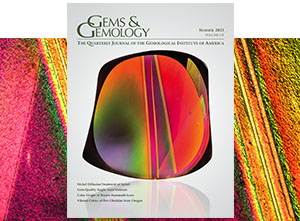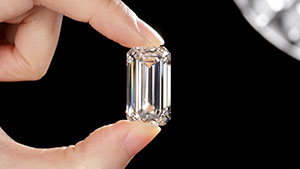
Article
Summer 2023 G&G Available Now
Erica Zaidman, August 4, 2023
An overview of the Summer 2023 Gems & Gemology content.
Read More

Color Modification of Spinel by Nickel Diffusion: A New Treatment
Michael Jollands, Abadie Ludlam, Aaron C. Palke, Wim Vertriest, Shiyun Jin, Pamela Cevallos, Sarah Arden, Elina Myagkaya, Ulrika D’Haenens-Johannson, Vararut Weeramongkhonlert, and Ziyin Sun, August 4, 2023
Reports on a newly discovered treatment process for producing a deep blue color in natural spinel and proposes identification criteria.
Read More

A Partially Hollow Natural Blister Pearl Filled with Foreign Materials
Roxane Bhot Jain, Abeer Alalawi, Nicholas Sturman, and Chunhui Zhou, January 25, 2023
A very large baroque white pearl is further examined in the Mumbai laboratory due to its suspicious heft.
Read More

Bismuth Glass-Filled Burmese Star Ruby
Xiaodan Jia and Mei Mei Sit, July 22, 2020
The Hong Kong laboratory recently examined a Burmese star ruby incorporating a significant amount of bismuth glass.
Read More

Article
CVD Diamond Over 34 Carats Examined in GIA’s Hong Kong Laboratory
Ka Wing Tam and Terry “Ping Yu” Poon, May 3, 2023
A look at the largest CVD diamond GIA has encountered to date.
Read More

Article
Color Modification of Spinel by Nickel (Ni) Diffusion: A New Treatment in the Gem Market
Michael Jollands, Abadie Ludlam, Aaron Palke, Wim Vertriest, Shiyun Jin, Pamela Cevallos, Sarah Arden, Elina Myagkaya, Ulrika D’Haenens-Johannson, Vararut Weeramongkhonlert, and Ziyin Sun, February 10, 2023
GIA researchers report on a new nickel-diffusion treatment used to modify color in spinel and present criteria for identification.
Read More

Composition and Spectral Characteristics of Porcelain-Treated Turquoise
Liying Huang, Quanli Chen, Yan Li, Zuowei Yin, Fengshun Xu, Xinxin Gao, and Yang Du, January 25, 2023
Characterizes turquoise treated with an inorganic additive that dramatically improves the luster and color of low- and medium-quality material.
Read More

Red-Dyed Spodumene Imitating Ruby
Guy Borenstein and Sean O’Neal, January 25, 2023
Testing identifies a “red corundum” sample as red-dyed spodumene.
Read More

Fluorescence Characteristics of Two Copper-Diffused Plagioclase Feldspars: Labradorite and Andesine
Qingchao Zhou, Chengsi Wang, and Andy H. Shen, January 25, 2023
Examines the use of strong fluorescence near 394 nm under 320 nm excitation as a potential means of identifying copper diffusion treatment of feldspar.
Read More

Gemological Characteristics of Low-Temperature “Gel-Filled” Turquoise
Quanli Chen, Andi Zhao, Yan Li, Yanhan Wu, and Tianchang Liu, November 11, 2022
A report on the examination of “gel-filled” turquoise produced in Zhushan County in Hubai Province, China.
Read More









